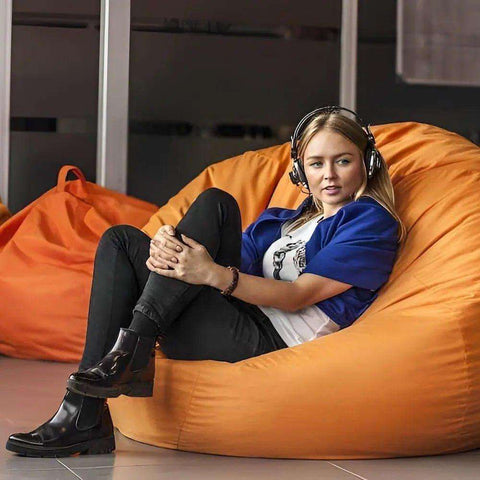When you work long hours remotely, a bean bag may be the solution to your neck and back pain. Learn how to create a home office with ergonomic design.
Working from home can be a wonderful thing. Not only can you stay at home with the family, but you don’t have to endure that ugly commute either. But it’s easy to lose yourself in your work, spending hours on spreadsheets or analyses. The next thing you know, your neck, back, and shoulders are screaming in pain, and you’ve got to do this all over again tomorrow. The effects of sitting all day aren’t just discomfort - they can lead to serious posture and health problems over time. Your chair should support the natural curve of your spine to avoid slouching. Proper back support is essential for maintaining a healthy posture and reducing back pain. An ergonomic chair provides adequate lumbar support, ensuring your back is properly supported throughout the day. However, with the right office ergonomics, you can create a home working environment that allows you to stay pain-free and productive.
Home Office Ergonomics 101
When you don’t have the optimal setup, not only can you develop painful injuries, but you can also lose productivity. Improper home office setups can negatively impact our bodies, leading to discomfort and health issues such as back pain and shoulder tension. Here are a few tips on how to make your home office more ergonomic so you can make sure your body stays in tip-top shape and pain-free, even if you work long hours.
Understanding Health Risks in the Home Office
Spending long periods working in a home office without proper ergonomics can have a significant impact on your overall health. Poor posture, an incorrect desk height, or a lack of lumbar support can all contribute to musculoskeletal disorders, such as back, neck, and shoulder pain. Sitting for extended periods in a chair that doesn’t support your body can also increase your risk of developing chronic conditions and even lead to eye strain if your monitor isn’t positioned at eye level. These health risks are not just uncomfortable—they can affect your productivity and well-being in the long run. By setting up an ergonomic home office with the right desk, chair, and monitor placement, you can reduce these risks and create a workspace that supports your body. Remember, taking regular breaks and moving around is just as important as your setup, as it helps counteract the effects of sitting and poor posture. Prioritising your ergonomic home office isn’t just about comfort—it’s an investment in your long-term health.
Pick the Right Desk
As long as it has a surface and four legs, then it’s fine. Well, you’d be surprised how important it is to have the perfect desk for your home study room. When selecting desks, it’s crucial to choose ones that are adjustable or can be modified to improve ergonomic comfort and reduce health risks. If you purchase a desk that’s too small and doesn’t have any storage functions, you’ll end up with a cluttered desk that barely accommodates your monitor or laptop. This can cause you to scrunch up when working, and you’ll inevitably end up with lots of pain, especially in your shoulders and neck. When choosing a desk, look for one that not only has a large surface area but also drawers. That way, you can put things such as pens, office supplies, and important papers into the drawers when you don’t need them.
Your desk height should allow your elbows to be at a 90-degree angle or slightly obtuse when typing. It’s essential to adjust your desk and chair to the correct height for your body, which helps prevent strain and discomfort. Desk height should also allow the elbows to remain at or near a 90-degree angle while seated. You’ll then be able to work with a clutter-free desk where you can position your mouse and keyboard comfortably (or place your laptop down in an optimal space).
If you’re working from a kitchen table or other non-traditional space, pay special attention to table height and how it affects your neck and head positioning. The kitchen table may not be at the ideal height for ergonomic comfort, so consider using accessories like pillows or risers to enhance your posture and alleviate discomfort.
Try a Standing Desk
Additionally, consider a sit-stand desk with adjustable height settings. Your body needs to be mobile during your working hours, and favouring seated work without regular movement can lead to discomfort and increase the risk of health issues. Alternating between sitting and standing throughout the day helps optimise comfort and reduce these risks. When using a sit-stand desk, it's important to adjust workstation components, such as the keyboard and monitor, each time you change the desk height to maintain proper ergonomics and prevent strain. An adjustable desk enables you to sit or stand to work so you get your blood flowing. Your desk should allow your forearms to be at elbow height when typing. Your chair height should allow your knees to bend at a 90-degree angle and be parallel to your hips. When you can stand while working, it’ll also decrease your chances of health problems, such as obesity, cancer, and diabetes. Plus, you’ll feel more energised and motivated to push on with your work when you don’t have to be stuck sitting for up to eight hours.
Choose the Right Home Office Chair
Your choice of home office chair can make or break your ergonomic setup. The right office chair should provide excellent lumbar support to maintain the natural curve of your spine, allowing you to sit comfortably for extended periods without risking back pain. Look for a home office chair that will enable you to adjust the seat height so that your feet rest flat on the floor (or on a footrest if needed), and your knees are at approximately a 90-degree angle. The chair should also allow you to sit with your shoulders relaxed and your upper arms close to your body, thereby reducing strain on your neck and shoulders. Proper ergonomics means your chair supports your entire body, from your lower back to your feet, so that you can focus on your work instead of discomfort. Investing in a quality office chair is one of the best ways to reduce the risk of pain and promote overall comfort and well-being in your home office.
Position Your Monitor Correctly
If you have a desktop computer, position the monitor approximately an arm's length away from you to help prevent eye strain and neck pain. Monitor height is also important—make sure the top of the screen is at or just below eye level to promote good posture and reduce neck strain. The monitor should be placed directly in front of you. Additionally, consider the number and type of monitors you use, as multiple monitors or different monitor types can affect ergonomic comfort and should be factored into your setup. These are also reasons why you need a good desk; if you don’t have the room to move your monitor around, it can cause eye strain, neck and shoulder pain, and possible injuries to your arms and hands. Improper monitor placement and lighting can also lead to computer vision syndrome, which causes headaches and eye strain. Ensuring your monitor is positioned correctly can help prevent these issues.
For Laptops
If instead, you use a laptop, you should still be aware and conscious of how far away your screen is, and the way it’s tilted. It may be helpful to get an adjustable laptop stand or a laptop riser to elevate your laptop to eye level, which helps maintain a neutral head and neck position. This is especially important for a long-term setup, where proper ergonomic adjustments—such as pairing a laptop riser with an external keyboard and mouse—can reduce neck and back strain during extended periods of work. Whether you’re sitting in a bean bag chair, an office chair, or in your bed, laptops have the advantage of enabling you to work wherever you are, but you have to be careful of your positioning, or it’ll be detrimental to your health. For example, you may find it comfortable to lie down sideways on the couch with your laptop completely sideways. But within an hour, you’ll find yourself hurting from head to toe.
Choose an Ergonomic Keyboard
Keyboards may seem boring and like any random one would work, but think about it: you’ll probably be using the keyboard 99% of the time you’re working from home, so it’s worth thinking about and splurging on if necessary. While the cheapest ones available are flat and may not even have a stand to flip up in the back, there are some that cost up to three figures that are designed to make typing like a dream. These ergonomic keyboards are not only angled, but they’re also split down the middle. Some are even completely split so you can place your hands in the best positions possible, separate of one another.
To help maintain the correct keyboard height and ergonomic positioning, consider using a keyboard tray, which allows for easy adjustments and helps optimise your desk setup for comfort and proper arm and wrist posture.
Ensure your wrists are in a neutral position when using the keyboard and mouse to avoid strain and discomfort during extended periods of work.
Choose an Ergonomic Mouse
The mouse is also something people often overlook. As long as you can move the cursor around on the screen and click on things, then it should suffice. You might opt for the cheapest mouse available, which is typically a small, uniformly round device. But these mice aren’t meant for hours of work; instead, they’re meant for a quick check on the internet while at the coffee shop. If you try to use these for hours on end, you’ll quickly develop hand cramps, especially if you have large hands. Carpal tunnel syndrome is caused by pressure on a nerve in the wrist and can be aggravated by poor ergonomic practices.
To reduce strain, always keep your mouse closer to your body to avoid awkward stretching or reaching. Poor mouse positioning can lead to shoulder discomfort and contribute to musculoskeletal issues over time.
Take the time to browse different types of ergonomic mice and try them out if you can. They should feel natural when resting your hands on them. Gaming mice can be a good choice since they’re designed for extended periods of use.
Ergonomic Keyboard and Mouse Placement
Setting up your keyboard and mouse correctly is essential for maintaining a healthy ergonomic position and preventing strain. Your ergonomic keyboard should be placed directly in front of you, at a height that allows your wrists to remain in a neutral position, meaning your hands are in line with your forearms, neither bent up nor down. This helps reduce the risk of repetitive strain injuries and keeps you comfortable during long hours of computer work. Keep your mouse close to your body and at the same level as your keyboard, so you don’t have to reach or stretch, which can cause shoulder and neck discomfort. Using an ergonomic keyboard and mouse, and ensuring they’re positioned properly, can help minimise eye strain and support your overall health while working in your home office.
Have a Bean Bag Chair in Your Home Office
This may seem unconventional, but consider purchasing a bean bag chair for your home office. You can still have a traditional setup of a desk and a chair, but having a bean bag chair in the corner can be great for ergonomics. When you find yourself getting stiff from sitting at your office desk, switch to the bean bag chair; this might be easier if you have a laptop, as it's more mobile. Bean bag chairs conform to your body, allowing you to shift around easily without discomfort. Bean bag chairs can also provide you with different working conditions to refresh yourself. If you find yourself getting bored with your office chair and desk, consider switching to the Big Boss Chair - one of the best chairs for long hours - for a fresh perspective and unmatched comfort.
Make Sure You Have Good Lighting
Without proper lighting, you are more at risk of eye strain. The first thing to check is your monitor's lighting. You should be able to look at it for long periods of time without having to squint; this can happen if it's either too dark or too bright. Bright, natural light is best for working on a computer or reading, and poor lighting can lead to eye strain. Since natural lighting can change throughout the day, ensure you adjust the brightness frequently to accommodate these changes. Another factor to consider is the lighting in your home office. If your desk receives a lot of natural light, ensure it is positioned away from the window to avoid glare on your screen. If it's often dark, you'll need to install the appropriate lighting fixtures to reduce eye strain. Taking a break from the screen for a couple of minutes, once or twice an hour, helps reduce eye strain and prevent headaches.
Take Regular Breaks
Sitting for hours in the same position can cause pain and soreness throughout your body, even if you have the best ergonomics setup. Make sure you get up and do something different every few hours. Not only should you take regular breaks, but you should incorporate some light exercises into your breaks as well. Taking regular breaks and stretching can help prevent injuries associated with prolonged sitting and repetitive movements. When we’re working, we tend to hunch over and tense up in one position for hours at a time. Use your small breaks as an opportunity to stretch out and relieve your tensed-up muscles.
Relieve Your Mental Stress
You can also "stretch out" your brain while you're taking these breaks. While it may seem productive to stare at the screen for hours without any rest, you might actually be less productive than if you'd taken a few short breaks. Doing something as simple as standing up and getting a glass of water can significantly boost your productivity. As you walk away from the screen, stretch your legs, and sip some cold water, your brain gets refreshed and reenergized. Think of the short pause as an investment towards your future productivity.
Common Mistakes to Avoid
Even with the best intentions, it’s easy to make mistakes when setting up your ergonomic home office. One common error is not adjusting your chair for proper lumbar support, which can lead to poor posture and back pain. Another frequent mistake is placing your monitor too high, too low, or too far away, which can cause eye strain and neck discomfort. Many people also forget to take regular breaks, which increases the risk of musculoskeletal issues from prolonged sitting in one position. If you’re using a laptop computer as your main device, avoid working without an external keyboard and mouse—this can force you into awkward positions and lead to discomfort. Instead, use a laptop stand to raise your screen to eye level, and consider adding an external keyboard and mouse for improved ergonomics. If your chair lacks lumbar support, a rolled-up towel or a dedicated cushion can provide extra comfort. By being mindful of these common pitfalls and prioritising proper ergonomics, you can create a supportive home office that protects your neck, back, and overall health for the long term.
Feel Comfortable and Be Productive in Your Home Office
By ensuring your home office ergonomics are the best they can be, you’re taking good care of your body and creating a stress-free work environment. A well-equipped home office, including ergonomic furniture and a well-organised workspace, is essential for comfort, productivity, and overall well-being. Working from home can definitely have its benefits, but it’s easy to lose yourself in work when you don’t have set hours or a commute to get to and from home. Getting a bean bag chair for your home office can not only be a fun addition but an ergonomic one as well. It’ll help you keep your body moving, which is instrumental in keeping pain and discomfort away. Plus, it’ll encourage your family to come in and hang out with you, since no one can resist a bean bag chair! If you’re ready to pick out a bean bag chair for your home office, then take a look at our bean bags now.






